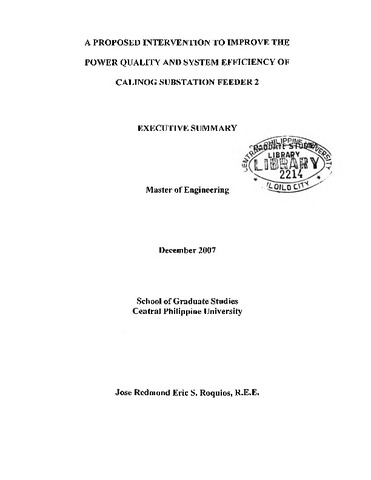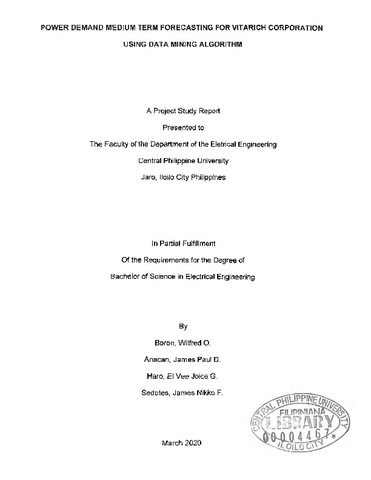Показать сокращенную информацию
Proposed wind power plant for power generation and irrigation system at Barangay Carabalan, Himamaylan, Negros Occidental
| dc.contributor.adviser | Molina, Dany C. | |
| dc.contributor.author | Vasquez, Rodel M. | |
| dc.coverage.spatial | Himamaylan | en_US |
| dc.date.accessioned | 2021-10-18T00:42:27Z | |
| dc.date.available | 2021-10-18T00:42:27Z | |
| dc.date.issued | 2002 | |
| dc.identifier.citation | Vasquez, R. M. (2002). Proposed wind power plant for power generation and irrigation system at Barangay Carabalan, Himamaylan, Negros Occidental (Unpublished Master’s special paper). Central Philippine University, Jaro, Iloilo City. | en_US |
| dc.identifier.uri | https://hdl.handle.net/20.500.12852/1580 | |
| dc.description | Introduction, statement of the problem, and objectives | en_US |
| dc.description.abstract | Introduction 1.1 Economic Condition The present power rate of National Power Corporation (NAPOCOR) is surging high due to inflation rate and maintenance cost of the existing Geothermal Power Plant that supplies electricity all through out the provinces of Negros Occidental, Negros Oriental and even extended to the island of Panay. This maintenance cost, and even system losses, has always been put into the burden of the consumers that makes life more miserable especially to the community of Barangay Carabalan, Negros Occidental. Besides, the said Barangay also suffers the need of water resources to maintain their agricultural and animal production. One way to solve this existing difficulty is to find a solution that can uplift the living condition of the said barangay, a solution related to the power consumption and water system for the agricultural and animal needs. Comes the plan of putting up a wind power plant for power generation and irrigation system to sustain the electrical consumption of the community and at the same time to supply water all throughout the different area of the said barangay, and if possible the neighboring barangays. 1.2 History Windmills or wind machines are devices that generate power or perform work by using the force of the wind. Other names used for windmills are wind turbine or aero- generators. Windmills usually consist of two or more blades or sails mounted on a shaft, from which power is taken. The power usually used to pump water or turn a generator to produce electricity. The first windmills were used for irrigation in Persia in about the fifteenth century A.D. Their use has spread throughout Europe by the 12th century. Early European windmills pumped water or turned the grindstones of com mills. During the late 19th century thousands of windmills were used in Europe and in the rural U.S., mostly for irrigation purposes. They were gradually displaced in Europe, however, by steam engines running on cheap coal, and in the U.S., by the rural electrification program of the 1930’s and 1950’s. With the sharp rise in energy prices in the 1970’s, interest revived in using machines to harness the “free energy” of the wind. Thus, the U.S. government rapidly increased funding for research and development of the wind power technology, and many other nations also invested in the wind energy programs. 1.3 Environmental Impact For over a century, primarily carbon fuels have powered our world. In recent years, concern about global warming and a harmful effect of fuel emissions has created new demand for clean and sustainable energy sources - like wind. In many areas around the globe, the energy market is also being driven by a dual new dynamic: deregulation and privatization. As more and more consumers choose who produces their power, the market for environmentally superior, or “green”, resources is forecast to expand at an even greater pace. The burgeoning global demand for power is astounding. Over the next 25 years, the world’s growing energy needs will require the construction of more electrical generating capacity than was built in the previous 100 years. With carbon power combustion being the number one caused of increased atmospheric levels of carbon dioxide, the leading cause of global warming, this increased demand for new energy sources is fueling a growing concern over the well being of our planet. In December 1997, at the United Nations Framework Convention on Climate Change in Tokyo, Japan, 160 nations reached a first-ever agreement to limit emissions of greenhouse gasses, including carbon dioxide. Most industrialized nations committed to reducing average national emissions over the period of 2008 to 2012 to approximately five percent below 1990 levels. To accomplish this multi-lateral commitment, many nations have turned to wind power. Today, more than 13,932 megawatts of wind energy are installed through out the world, and are forecast to reach approximately 47,000 megawatts by the year 2004. With a cost of energy of approximately 3.5 - 4 cents per kilowatt hour and declining, wind is the least cost renewable, less expensive than coal, oil or nuclear, and most natural gas fired generation, and is becoming attractive to utilities and electric cooperatives. Consumers, too, are showing their preference for clean power. In areas around the world where consumers can choose their electricity suppliers, a substantial percentage is opting to buy “green” electrons, even at a premium. At Enron wind the personnel are committed to making wind power as economically viable as it is environmentally sound. Through their team’s ingenuity and resolve they deliver cost effective and reliable wind power today and diligently work to ensure its place in the world’s energy portfolio. “Regional and global climate changes are expected to have wide-ranging and potentially adverse effects on physical and ecological systems, human health, and socioeconomic sectors. This will affect the economy and the quality of life for this and future generations. The balance of evidence suggests a discemable human influence on global climate.” - Intergovernmental Panel on Climate Change, Second Assessment, Report, 1996. Since the industrial revolution, the earth’s atmospheric carbon dioxide levels have risen from an estimated 280 parts per million to 362 parts per million - the highest levels experienced in 160,000 years. Current estimates are that carbon dioxide emissions could grow 50 percent by 2010. Today, approximately 1.4 pounds of carbon dioxide is emitted for every kilowatt- hour of electricity generated in the U.S. The addition of a single 1.5 MW wind turbine generator, capable of producing approximately 4 million kilowatt-hours each year, would estimates 5.6 million tons of carbon dioxide annually. “New wind power projects have now reached economic parity with new coal- based power plants. And as the technology continues to improve, further cost declines are projected, which could make wind power the most economical source of electricity in many countries” - Christopher Flavin, World watch Institute Vital Signs 1999. 1.4 Statement Of The Problem Economic problems have called strong attention worldwide since then. Since global economic problems are international issues, affecting the earth as a whole, countermeasures require systematic approach through international cooperation. It is, therefore, practical to start from coping with the local economic problems where we try to address the economic problems as a whole. This study outlines the local economic issues affecting the economic condition of the populace, followed by the structuring, utilization and economic share of wind power plant as a main source of household electricity and as a pumping station for watering the nearby agricultural plantations and domestic animals. Some portion of Barangay Carabalan is suffering from the accessibility to electric power supply, and at the same time from the irrigation system. Almost majority of its land area relied on the pouring of rain for cultivation of their agricultural land. It is a lofty area that irrigation system from the local government cannot supply the needs of their plantation. In the inner part of the barangay, there are rivers/creeks that are potentially source of water supply to their farm and domestic animals but stayed insignificant because of people’s lack of innovation to utilize it. If given attention, the proposed study can supply the water needs of all areas of the barangay and even the neighboring barangays. Presently, only a small portion of the area in the lowest part of Himamaylan avails the water of that Bingig River. 1.5 Objectives The main objective of the proposal is to construct a farm windmill (aero generators) to supply electricity to the whole community of the said Barangay and at the same time utilized it as a pumping station to supply water (irrigation system) to their agricultural land and domestic animals. With these plans, the people can avail the lowest cost of electrical consumption, improve their agricultural production, and as a whole, improve their living condition. With the proposed construction of wind power plant, it necessitates personnel for its operation and maintenance, meaning, a reduction of unemployment rate. Also, the additional cultivation of land areas due to good supply of water coming from the pumping station of windmill increases workforce for land preparation and cultivation and even until harvest time. | en_US |
| dc.format.extent | 63 leaves | en_US |
| dc.language.iso | en | en_US |
| dc.subject.ddc | GSL Theses 620.0072 V448 | en_US |
| dc.subject.lcsh | Windmills--Design and construction | en_US |
| dc.subject.lcsh | Wind power | en_US |
| dc.subject.lcsh | Wind power plants | en_US |
| dc.subject.lcsh | Irrigation--Power supply | en_US |
| dc.subject.lcsh | Wind power plants--Design and construction | en_US |
| dc.subject.lcsh | Philippines--Negros Occidental--Himamaylan | en_US |
| dc.title | Proposed wind power plant for power generation and irrigation system at Barangay Carabalan, Himamaylan, Negros Occidental | en_US |
| dc.type | Special paper | en_US |
| dc.description.bibliographicalreferences | Includes bibliographical references | en_US |
| dc.contributor.chair | David, Fely P. | |
| dc.contributor.committeemember | Rio, Walden S. | |
| dc.contributor.department | School of Graduate Studies | en_US |
| dc.description.degree | Master of Engineering | en_US |





